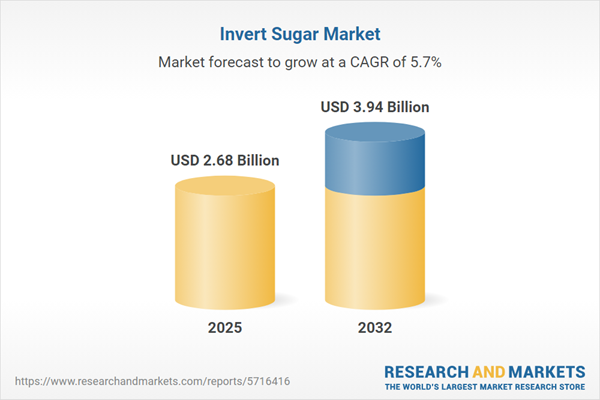Speak directly to the analyst to clarify any post sales queries you may have.
The invert sugar market is evolving rapidly, shaped by shifting regulations and increasing demand for wellness-oriented sweetener solutions. Senior decision-makers are focusing on strategic procurement and resilient supply chain management to stay competitive amid global complexities.
Invert Sugar Market Snapshot
The global invert sugar market shows robust momentum, driven by advances in manufacturing technology and a clear market shift towards clean-label ingredients. Transparent and traceable supply chains now define competitive advantage, as consumer and regulatory expectations for transparency continue to grow. With the adoption of standardized labeling, suppliers find new opportunities in the bakery, beverage, and confectionery sectors, while dairy and pharmaceutical applications introduce unique, value-driven demands. As regulatory frameworks advance, procurement and compliance leaders must rely on accurate, actionable intelligence to mitigate risk and support long-term planning.
Scope & Segmentation: Invert Sugar Market
This comprehensive report is tailored to the needs of ingredient buyers, procurement managers, and supply chain executives pursuing opportunities in the invert sugar sector. Detailed market segmentation enables well-informed sourcing strategies, supplier engagement approaches, and agile negotiation practices across the supply chain.
- Source Types: Beet, cane, and corn supplies play an essential role in raw material choices, directly impacting supply security and cost management.
- Product Forms: The market offers crystalline, liquid, and powder variants, allowing manufacturers flexibility to optimize for their production environments and end-use needs.
- Application Areas: Bakery, beverage, and confectionery stand out as primary use cases, while dairy and pharmaceutical industries create demands for tailored sourcing and advanced product development.
- Distribution Channels: B2B operations span industrial applications, food service, retail distribution, online sales, and specialty distributors, requiring advanced logistics and network coordination.
- Fructose Concentration: Markets address specific nutritional and processing needs through standard-grade and high-fructose formulations, supporting differentiated product positioning.
- Key Regions: Regional markets—including the Americas, Europe, Middle East & Africa, and Asia-Pacific—shape compliance requirements and influence supplier choice and sourcing patterns.
- Technological Innovations: Adopting enzymatic hydrolysis, membrane filtration, and continuous-flow processes yields efficiency gains and supports the development of new product functionalities.
Key Takeaways for Senior Decision-Makers
- Monitor changes in regulatory landscapes to refine labeling strategies and ensure ongoing compliance in major regions.
- Invest in enzymatic and filtration technologies to extend operational flexibility and strengthen competitive differentiation across diverse sweetener segments.
- Enhance integration between procurement and R&D teams to accelerate response to increasing demand for natural and functional sweeteners.
- Diversify sourcing networks and supplier bases to reduce dependency risks and bolster supply chain robustness, especially in a globalized market.
- Raise transparency standards by implementing advanced traceability protocols and non-GMO compliance initiatives, thereby reinforcing partner and customer trust.
- Leverage digital management systems to expedite information sharing and maintain supply chain agility when facing regulatory or market fluctuations.
Tariff Impact
Tariffs on imported invert sugar in the United States have prompted cost re-evaluation across the sector. Industry leaders are strengthening focus on domestic and trade-exempt sourcing to maintain a market edge. Expanding the variety of suppliers and fortifying agile supply chains are critical to reducing exposure to tariff-driven volatility and safeguarding product consistency.
Methodology & Data Sources
This analysis is grounded in interviews with senior executives, expert opinion, and practical consulting experience. Validation relies on proprietary corporate datasets, regulatory filings, and peer-reviewed industry literature to ensure high-quality, actionable insights for decision-makers.
Why This Report Matters
- Supports executives in shaping strategies that emphasize clean-label credentials and transparency, critical for differential positioning in today’s sweetener market.
- Provides clear recommendations to boost procurement and compliance agility and maintain operational continuity during periods of regulatory and market change.
- Enables robust risk management and supply chain stability within increasingly dynamic market and sourcing landscapes.
Conclusion
The insights and recommendations in this report equip senior leaders to enhance supply chain resilience, enforce compliance, and continuously foster innovation in the evolving global invert sugar market.
Additional Product Information:
- Purchase of this report includes 1 year online access with quarterly updates.
- This report can be updated on request. Please contact our Customer Experience team using the Ask a Question widget on our website.
Table of Contents
3. Executive Summary
4. Market Overview
7. Cumulative Impact of Artificial Intelligence 2025
Companies Mentioned
The companies profiled in this Invert Sugar market report include:- Cargill, Incorporated
- Archer-Daniels-Midland Company
- Tate & Lyle PLC
- Ingredion Incorporated
- Tereos SCA
- Südzucker AG
- Roquette Frères
- Nordzucker AG
- E.I.D.-Parry (India) Ltd.
- Batory Foods, Inc.
Table Information
| Report Attribute | Details |
|---|---|
| No. of Pages | 187 |
| Published | November 2025 |
| Forecast Period | 2025 - 2032 |
| Estimated Market Value ( USD | $ 2.68 Billion |
| Forecasted Market Value ( USD | $ 3.94 Billion |
| Compound Annual Growth Rate | 5.6% |
| Regions Covered | Global |
| No. of Companies Mentioned | 11 |









